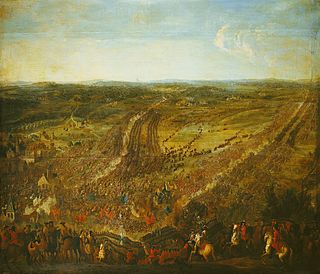
The Battle of Fleurus, fought on 1 July 1690 near the town of Fleurus in modern Belgium, was a major engagement of the Nine Years' War. In a bold envelopment, Marshal Luxembourg, commanding a French army, inflicted a severe defeat on an Allied force led by Prince Waldeck.

The Battle of Seneffe took place on 11 August 1674 near Seneffe in present-day Belgium during the Franco-Dutch War. It was fought between a French force commanded by the Prince de Condé and a combined Dutch, Imperial, and Spanish force under William of Orange. One of only three battles fought in the Spanish Netherlands during the war, Seneffe was the most costly in terms of casualties, although estimates vary considerably.

The Battle of Turckheim was a battle during the Franco-Dutch War that occurred on 5 January 1675 at a site between the towns of Colmar and Turckheim in Alsace. The French army, commanded by the Viscount of Turenne, defeated the armies of Austria and Brandenburg, led by Alexander von Bournonville and Frederick William, Elector of Brandenburg.

Henri de La Tour d'Auvergne, vicomte de Turenne, commonly known as Turenne[ty.ʁɛn], was a French general and one of only six Marshals to have been promoted Marshal General of France. The most illustrious member of the La Tour d'Auvergne family, his military exploits over his five-decade career earned him a reputation as one of the greatest military commanders in history.
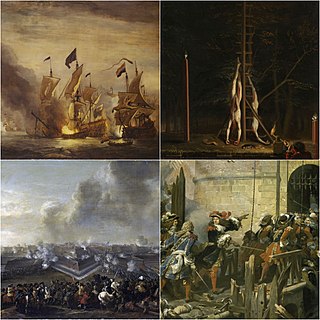
The Franco-Dutch War, also known as the Dutch War, was fought between France and the Dutch Republic, supported by its allies the Holy Roman Empire, Spain, Brandenburg-Prussia and Denmark-Norway. In its early stages, France was allied with Münster and Cologne, as well as England. The 1672 to 1674 Third Anglo-Dutch War and 1675 to 1679 Scanian War are considered related conflicts.

The Battle of Cassel, also known as the Battle of Peene, took place on 11 April 1677 during the Franco-Dutch War, near Cassel, 15 km (9 mi) west of Saint-Omer. A French army commanded by the duc de Luxembourg defeated a combined Dutch–Spanish force under William of Orange.

The Battle of Saint-Denis was the last major action of the Franco-Dutch War (1672-78). It took place on 14 August 1678, four days after Louis XIV of France had agreed the Treaty of Nijmegen with the Dutch Republic, but before he finalised terms with Spain. The battle was initiated by the Dutch and Spanish forces to prevent the French capturing the Spanish-held town of Mons, then on the border between France and the Spanish Netherlands. The result was disputed, as both sides claimed victory.
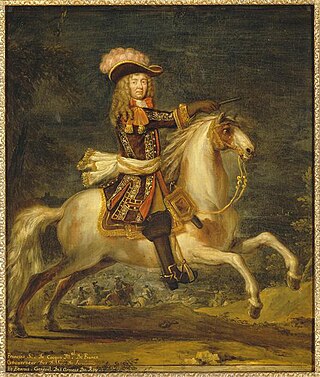
François de Blanchefort de Créquy, later Marquis de Marines, 2 October 1629 to 3 February 1687, was a 17th-century French noble and soldier, who served in the wars of Louis XIV of France.

The Battle of Herbsthausen, also known as the Battle of Mergentheim, took place near Bad Mergentheim, in the modern German state of Baden-Württemberg. Fought on 5 May 1645, during the Thirty Years War, it featured a French army led by Turenne, defeated by a Bavarian force under Franz von Mercy.

The Battle of Salzbach, or Sasbach, took place on 27 July 1675 during the Franco-Dutch War, when an Imperial army under Raimondo Montecuccoli confronted a French force commanded by Marshal Turenne. The "battle" consisted primarily of an artillery duel, during which Turenne was killed by a cannonball.
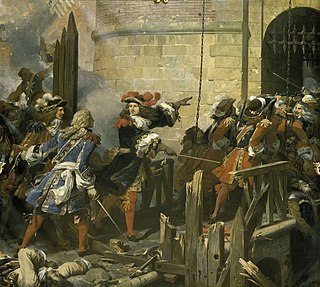
The siege of Valenciennes took place from 28 February to 17 March 1677, during the Franco-Dutch War, when Valenciennes, then in the Spanish Netherlands, was attacked by a French army under the duc de Luxembourg.

The Battle of Les Avins or Avein took place on 20 May 1635, outside the town of Les Avins, near Huy in modern Belgium, then part of the Bishopric of Liège. It was the first major engagement of the 1635 to 1659 Franco-Spanish War, a connected conflict of the Thirty Years' War.

The Battle of Valenciennes was fought on 16 July 1656 between the Spanish troops commanded by John Joseph of Austria and the French troops under Henri de la Tour d'Auvergne, Vicomte de Turenne, in the outskirts of the said city in the Spanish Netherlands during the Franco-Spanish War. After a period of Spanish recovery following the Peace of Münster in 1648, France went again on the offensive in 1654, having succeeded in suppressing internal rebellions, and took several towns in the province of Hainaut over the course of two years. On early 1656, Turenne was instructed by the French court to continue the offensive. He intended at first to besiege Tournai, but realising that it had been strongly reinforced by the Army of Flanders under the newly-appointed John Joseph of Austria, illegitimate son of Philip IV of Spain, he went instead to besiege Valenciennes, in the course of the Scheldt river.

Bernardin Gigault, Marquis de Bellefonds was a French nobleman, military officer and courtier who was appointed Marshal of France in 1668 and held a number of senior positions in the personal household of King Louis XIV.

The Battle of Entzheim, also called Enzheim, or Ensheim, took place on 4 October 1674, during the 1672 to 1678 Franco-Dutch War. It was fought near the town of Entzheim, south of Strasbourg in Alsace, between a French army under Turenne, and an Imperial force commanded by Alexander von Bournonville.

The Battle of Mulhouse took place on 29 December 1674 in Alsace, part of Turenne's Winter Campaign during the Franco-Dutch War. It was fought by the French army under Turenne and part of Alexander von Bournonville's Imperial army commanded by Hermann of Baden-Baden.
Turenne's Winter Campaign took place during the Franco-Dutch War of 1672-78. During December 1674 and January 1675, Henri de la Tour d'Auvergne, Vicomte de Turenne, led French forces on a flank march that resulted in the defeat of an army fielded principally by the Holy Roman Empire and in that army's expulsion from Alsace.
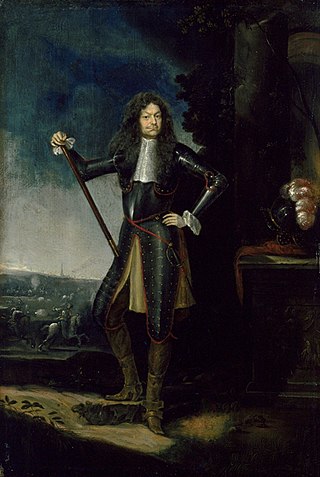
The Battle of Altenheim took place on 1 August 1675 during the 1672-1678 Franco-Dutch War near Altenheim, in modern Baden-Württemberg. It was fought by a French army of 20,000, jointly commanded by the Marquis de Vaubrun and the Comte de Lorges, and an Imperial Army of 30,000 under Raimondo Montecuccoli.
The Battle of Ortenbach, also known as the Battle of Gengenbach, took place on 23 July 1678 during the closing stages of the 1672-1678 Franco-Dutch War, in the modern German state of Baden-Württemberg. It featured a French army commanded by François de Créquy and an Imperial force under Charles V, Duke of Lorraine.

Sir George Hamilton, Comte d'Hamilton was an Irish soldier in English and French service as well as a courtier at Charles II's Whitehall.



















